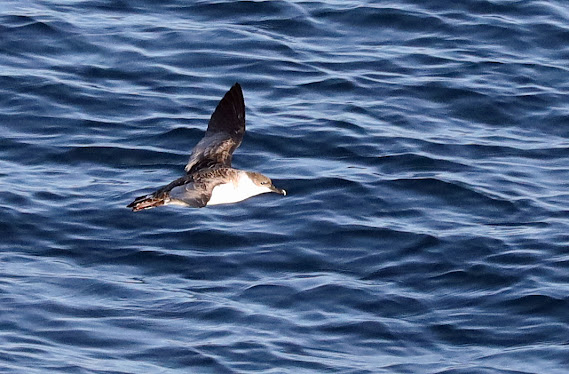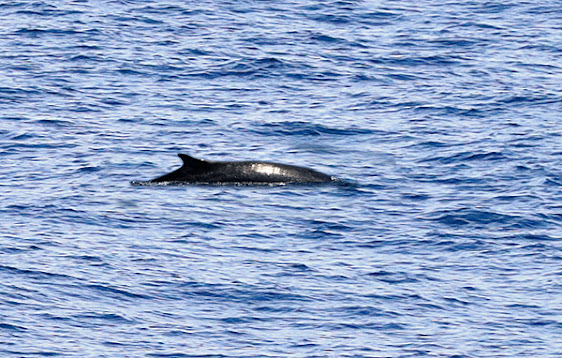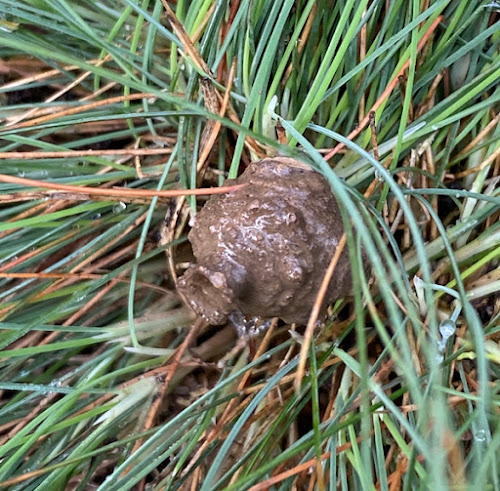On 13th September Jackie and I along with friends Margaret & Liz headed off to Plymouth for an overnight stay as next day we were joining the ORCA Whale and Dolphin Conservation on the Brittany Ferry mini cruise from Plymouth to Santander in Spain and meeting our friends Jackie & Kit with the idea for the trip to see as many cetaceans as possible as we pass across the deep water areas and deep trenches of the Bay of Biscay. Of course hoping for some good seabirds on our way.
We embarked around 12:30hrs once on board we put our bags into our cabin then went to a welcome talk by ORCA then we had a quick lunch and headed out on deck. We were still in view of land when we saw our first Cory's Shearwater and by the time we were approximately 30 miles from the coast we were seeing many Cory's and mixed in were the odd Gannet and Great Shearwater, it was some time before we saw our first Manx. I suppose it was about 2 hours after sailing that we saw our first cetaceans Common Dolphin which was the species we saw most throughout the trip.
 |
| Cory's Shearwater © Nick Hull |
 |
| Common Dolphin © Nick Hull |
 |
| Great Shearwater © Nick Hull |
Towards the end of the the day we were over the Atlantic Shelf and one of the deep trenches of Biscay and we saw our first Whale species in fact we saw one then two Long-finned Pilot Whale surface. These are a small species of whale weighing in around 3 tons with a max length of around 6 - 7 metres.
 |
| Cory's Shearwater and Long-finned Pilot Whale - Bay of Biscay © Nick Hull |
A good tip when out on a cetacean watch look out for the Shearwaters and Gannets etc particularly if they are circling an area as often there are whales or dolphin below the surface or about to surface as seen in the shot above a Cory's Shearwater escorting the Pilot Whale.
A while later we saw a blow it was like a column high into the air and lasted a few seconds before it dissipated off the port-side fairly distant, I raised the camera waiting for the next blow and hoped for a view, second blow came up no view then a third blow and a back and dorsal fin came into view and I shot off a few frames in the hope I'd get something.
 |
| Fin Whale - Bay of Biscay © Nick Hull |
As you can see above I managed a shot and with a bit of a crop a pretty respectable one at that. This shot doesn't give the impression on the size of this species and indeed it may not be a full adult size animal. Fin Whale are the second largest with a max length of around 26 metres and weighing in from anything from 40 to 80 tons they are an impressive whale. A little later we had more blows and had at least three more individuals off the starboard-side of the ship.
Before it was time for dinner we managed to add Great and Arctic Skua and a Sooty Shearwater which were all around groups of feeding shearwater. Also Sunfish, Portuguese Man-of-War and quite a few Blue-fin Tuna were seen.
Next morning we were up early and out on deck before breakfast but it turned out to be very quiet just with a few shearwaters passing by. As we were due to reach port in Santander in an hour or so we decided to go for breakfast. By the time we had docked the weather was sunny and hot and Jackie and I decided to stay on board and watch the mountains and harbour for birds and just rest for the couple of hours before we sailed again on the reverse journey back to Plymouth. We didn't expect to see too much in and around the Port and harbour but we added Cormorant, Yellow-legged Gull and the ubiquitous Feral Pigeon and Jackdaw. What was a little odd we had a flight of geese fly in from the sea direction which were possibly Canada Geese, there was also a flight of Teal that flew in and headed inland. Scanning over the mountain tops that surround the port we managed and few distant Griffon Vulture moving across from one mountain to the next.
As passengers were coming back on board Jackie and I went off to lunch and we headed back up on deck prior to sailing meeting our friends again after their walk ashore and scanning the mountain-tops again managed to get a couple of Griffons for them to add to their trip lists just prior to sailing.
Leaving Santander we had very little for possibly three hours just the odd Gannet and Shearwater. It was in the late afternoon before we had the first sighting of Common Dolphin and then shortly after a small pod of Risso's Dolphin surfaced near to the ship and then more Risso's then we had large groups of both Cory's and Great with a few Manx and a single Balearic Shearwater. We had a small group of passerines pass going south which were possibly pipit species and we had a 'alba' Wagtail go over heading north. It was now heading toward time for our evening meal and Jackie and friends went to freshen up for dinner and I had some extra time on deck with the ORCA team and a few other diehards. Then came a call 'sighting' and looking in the direction the guy was pointing I saw a small whale breach clear of the water and as I went for my camera one of the ORCA team raised her camera and I had to step slightly left and I missed taking a shot of the second animal breaching. Fortunately Charlotte managed a respectable shot and shared it with me. When analysed the photograph turned out to be a life tick for me and Charlotte a Northern Bottlenose Whale. They are the largest and scarcest of the beaked whales at around a max of 9 metres and between 6.5 - 7.5 tons and like other beaked whale species a squid hunter and found in the deeper parts of Biscay.
 |
| Northern Bottlenose Whale breaching Bay of Biscay © Charlotte Kirchner |
We had a few blows from several Fin Whale and then observation just started to slow down and Jackie is on deck telling me I had 20 minutes to be ready to go to dinner so ended another day.
Our last morning we were again up early and on deck and we were back into the Shearwaters, a Fulmar or two, one or two Manx and another Balearic Shearwater and a single Sooty and we started to see a number of gulls Herring Lesser-black and Great Black-backed Gull and as we approached the outer harbour of Plymouth Black-headed Gull and a Mediterranean Gull were seen
 |
| Cory's Shearwater © Nick Hull |
It was good to spend a few days with friends and do some serious sea watching and be with a group of interested people looking for Cetaceans and helping them with their seabird identification skills. and learning a little more about the Cetaceans of Biscay from the ORCA guides.


















